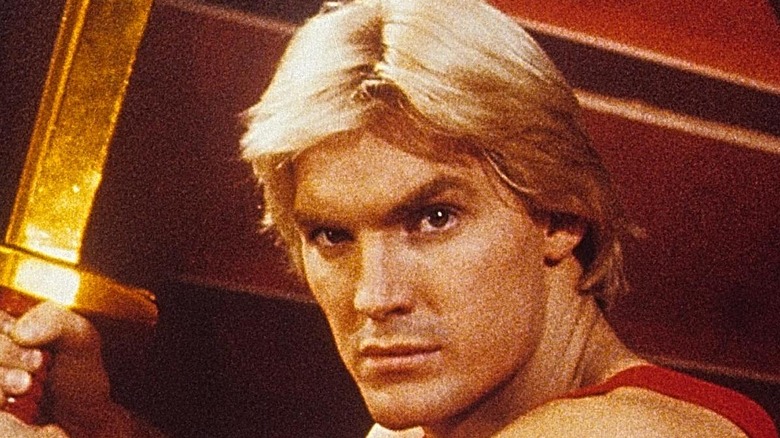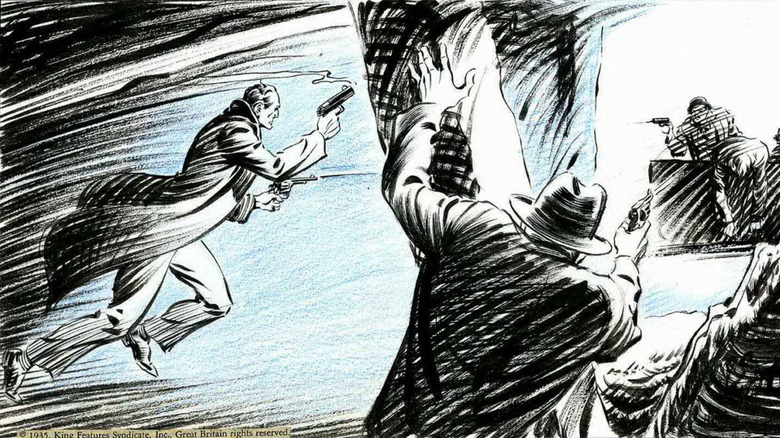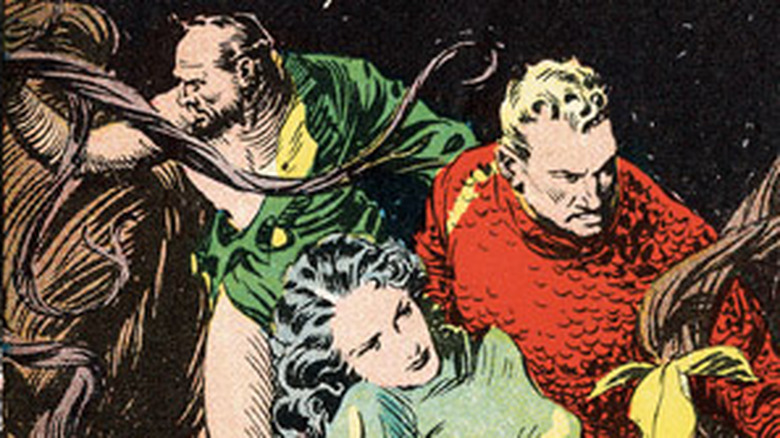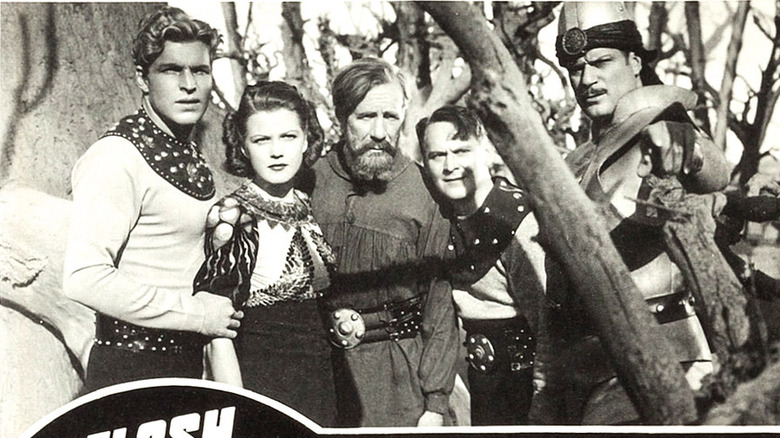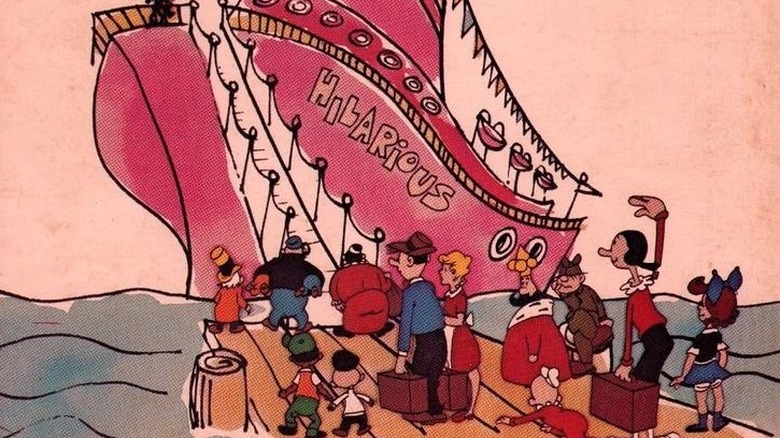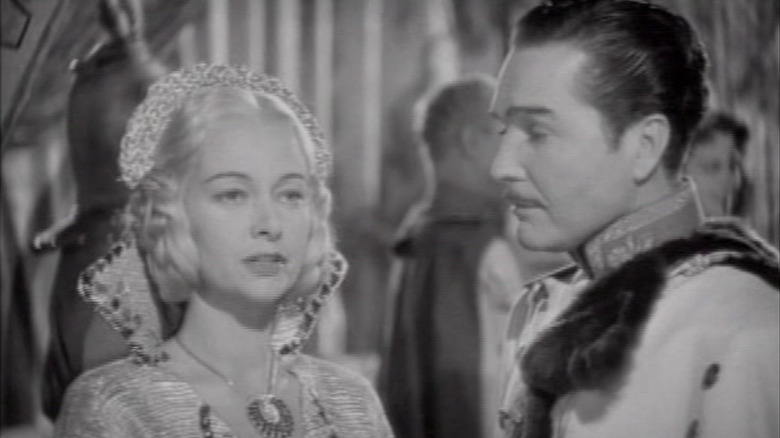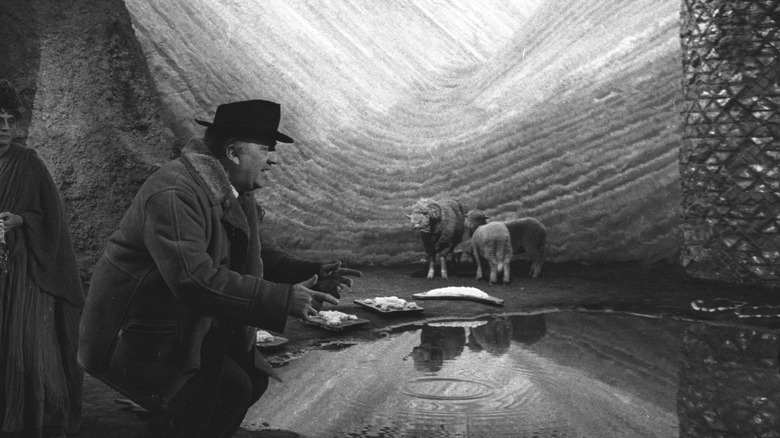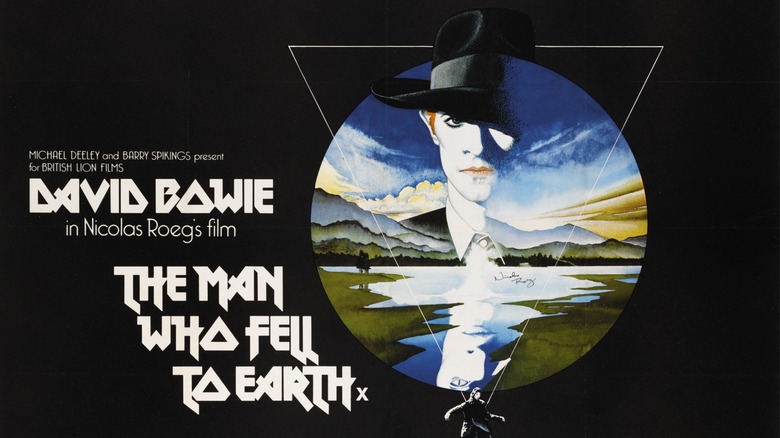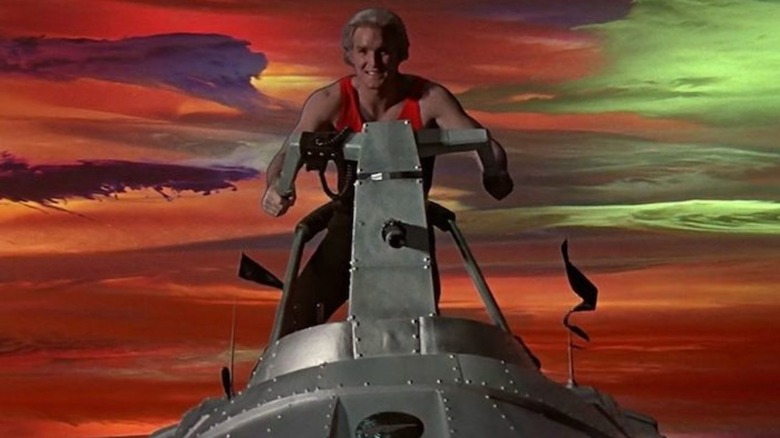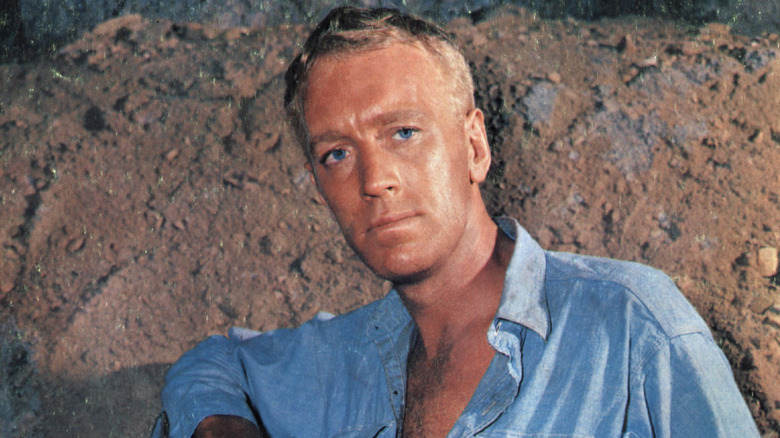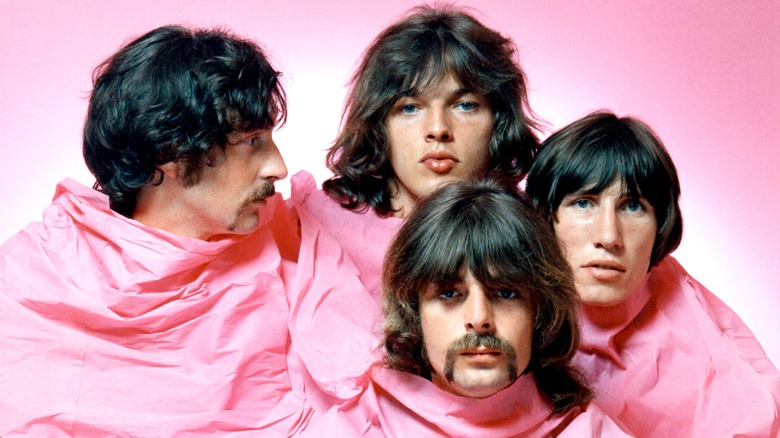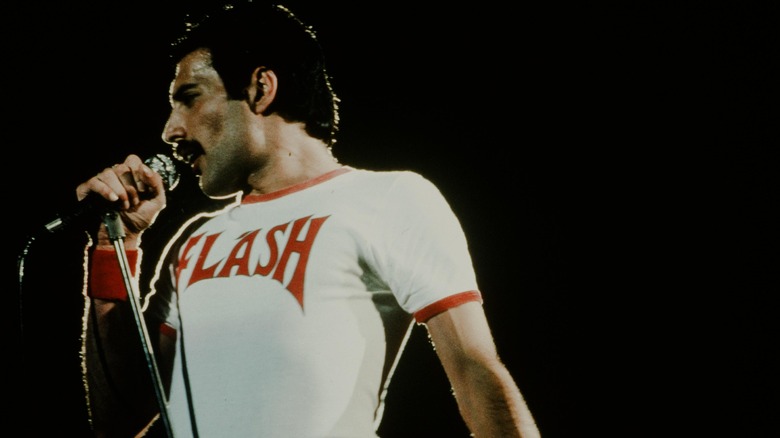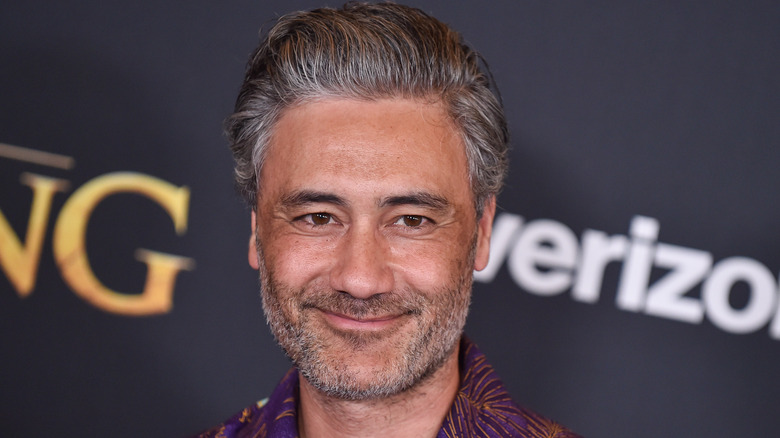The Untold Truth Of Flash Gordon
Say it with us now: Flash! Ah-ah! Savior of the universe! Even before "Flash Gordon" hit the big screen in 1980, the comics and serials were already some of the founding texts of science fiction, creating a world where sword-wielding knights rode into battle on alien creatures or rocket ships. And while it was ironically Flash's least successful incarnation in its own time, producer Dino DeLaurentiis and director Mike Hodges' interpretation of the character is the one that's endured.
Made in the first flush of "Star Wars" mania, "Flash Gordon" might seem like a cash-in, but it offered a totally different vision of what science fiction could be. Where "Star Wars" made the impossible real with groundbreaking effects and a gritty, grungy aesthetic, "Flash Gordon" reveled in colorful artificiality. Where "Star Wars" treated its ridiculous plot with all the awe and wonder of a kid seeing it for the first time, "Flash Gordon" treated it all with a knowing wink but still kept the delicate balance separating it from self-parody. All these things doomed "Flash Gordon" in 1980, but they've made it a beloved cult classic today. But even the most devoted fans may not know everything about their hero. Here's just a few facts you may have missed.
Flash Gordon's creator collaborated with the creator of The Maltese Falcon
"Flash Gordon" was the brainchild of Alex Raymond, a former Wall Street clerk who was forced to find a new career after the 1929 crash. He began taking night classes in art and assisting on a variety of comic strips, including "Blondie," where he drew the crowd at the title character's wedding to Dagwood. Raymond got his big break in 1933, when King Features was looking for new features to compete with some of the biggest comics of the time — "Buck Rogers," "Tarzan," and "Dick Tracy." Raymond would end up drawing all three, creating a new science fiction comic that would soon eclipse its inspiration, supported by a "topper" called "Jungle Jim" that would give readers some of the same tropical adventures they'd been reading in "Tarzan."
That would end up becoming his legacy, but Raymond also launched King's attempt at a detective strip to compete with "Dick Tracy," and the syndicate went for the big guns on "Secret Agent X-9" by hiring the biggest detective writer of the era to fill in Raymond's balloons. The first few months of the strip were written by Dashiell Hammett, who's been celebrated even outside the genre for his tight prose in classic novels and movies like "The Maltese Falcon," "Red Harvest," and the "Thin Man" series. With a master as his mentor, Alex Raymond was ready to create one of the greatest comic strips of all time.
Flash Gordon predicted the atom bomb
"Flash Gordon" was a huge hit, which says a lot for its readers' taste because it's also a masterpiece. Raymond was one of the first comics artists to draw more from "serious" illustration than other cartoonists, and "Flash Gordon" stands up to the best work in either field. The strip began with the threat of another planet crashing into Earth and Flash Gordon and Dale Arden stumbling onto Dr. Zarkov's plan to land on the strange world's surface. They discovered the planet Mongo, ruled by Ming the Merciless and populated by lionmen, hawkmen, snakemen, and whatever other weird critters Raymond and his successors could think up for the next 70 years.
Science fiction was still fairly new in the early '30s, and Raymond did as much as any writer to invent it. And like the best sci-fi creators, he ended up getting out ahead of reality. In one story collected in "Flash Gordon on the Planet Mongo," Flash and friends defend an underwater city from Ming's army with an "atom cannon," six years before the start of the Manhattan Project. Could Raymond have predicted where atomic warfare was headed in the next decade? He may have been a prophet, or he may have been inspired by H.G. Wells' novel "The World Set Free." Or he may have just been throwing science-y sounding words together and happened to find one that stuck — the same book also includes "dissolvo-rays" and "spaceo-graphs."
Flash Gordon went to Mars to cash in on War of the Worlds mania
"Flash Gordon" was so big he was one of the first comics heroes to hit the big screen, before comic books as we know them even existed. 1936's "Flash Gordon" was one of the most successful movies released in the serial format, with new episodes appearing in theaters every week. It was so successful it inspired a sequel, "Flash Gordon's Trip to Mars," in 1938, just as Mars became big news.
A young Orson Welles was directing and starring in the radio anthology series "Mercury Theater on the Air," and for Halloween that year, he adapted H.G. Wells' Martian invasion story "War of the Worlds." Welles told the story in an innovative new format that predicted both mockumentaries and found footage horror, "interrupting" the broadcast with emergency news bulletins about alien invaders. The show inspired a media frenzy, with rumors that Welles caused a mass panic by convincing listeners that aliens really were invading. Universal cashed in on the Mars mania by releasing a feature-length edit of "Flash Gordon's Trip to Mars" as "Mars Attacks the Earth."
Flash Gordon met every other comic character there is in The Man Who Hated Laughter
Flash Gordon would have to wait until 1980 for another big-screen movie, but he did make a small appearance on the small screen in "Popeye Meets the Man Who Hated Laughter." This episode of "The ABC Saturday Superstar Movie" anthology series featured nearly every comics character under the King Features umbrella. The title villain is Dr. Morbid Grimsby, who hates laughter so much he wants to put it to an end by kidnapping King's comics stars, which sounds a lot like unjustified ego on the syndicate's part. To do this, he sends them fake invites for a cruise on the Popeye-piloted SS Hilarious (somehow he convinces Beetle Bailey the invitation came from his general, who's sitting next to him when he gets it).
While the comedy characters are trapped, the President himself (!) sends the action heroes to rescue them, including the Phantom, Mandrake the Magician, and Flash Gordon. Confusingly, even though he's in the boardroom with them at the beginning, they have to call him in from space later. Even hardcore Flash fans probably don't need to bother with this one: with so many characters fighting for screen time, there's hardly any room for him. Then again, since everyone's played by the same actor and the art's so bad there's no way to tell Flash from the equally blond, equally square-jawed hero Steve Canyon, it's a little hard to say just how much he's in it.
Star Wars began as a Flash Gordon movie
The "Flash Gordon" movies were probably never intended for posterity, but they had a long second life on TV. They found a whole new audience on the air, including a young George Lucas. His "Star Wars" series' importance to the science fiction genre passed up "Flash Gordon" long ago, but it would never have happened if "Flash" hadn't gotten there first. Empire reports that Lucas' genre-changing epic originally began life as a "Flash Gordon" movie. The young filmmaker got a dream job scanning Raymond's original art to microfiche for King Features, and he managed to save some for himself before his bosses could throw it in the trash. Later, he went to them for a chance to make a "Flash" movie, but he learned the job was already taken by producer Dino DeLaurentiis.
He was discouraged, but he went ahead and made his own version, a little movie about wars in the stars you might have heard of. "Flash" fans should see the inspiration all over it. The iconic opening crawl was based on the recap text that opened every "Flash Gordon" episode, and the ice queen Fria wore Leia's equally iconic side-bun hairdo in "Flash Gordon Conquers the Universe." Even Raymond's love of anachronistic sword fights got an update in the lightsabers that defined Lucas' franchise. We can only imagine how hard the folks at King kicked themselves when they realized they'd said no to one of the biggest movies of all time.
Italy's greatest filmmakers wanted to direct Flash Gordon
In King's defense, it's hard to imagine a better director than the one DeLaurentiis had picked for "Flash Gordon." According to Empire, when Lucas applied for the job, the great Italian filmmaker Federico Fellini was sitting in the director's chair. Fellini had made his name with some of the most acclaimed movies ever made, and films like "Amarcord" and "8 ½" show a talent for colorful, fantastical imagery that has us drooling to see what he could do with a full-on science fiction epic.
And Fellini was just as enthusiastic to take the job. He'd grown up on Raymond's original comics, and when Mussolini banned them after rising to power, Fellini planned to draw his own comics to take their place. Sadly, we'll never know what Fellini's Flash might have looked like, but his replacements on the project still included a tribute to him, giving his name to Princess Aura's servant.
Fellini wasn't the only Italian master DeLaurentiis courted for the job. Little White Lies also names Sergio Leone. He'd already proven he knew how to adapt American pop culture when he kickstarted both Clint Eastwood's career and the "Spaghetti western" subgenre with "A Fistful of Dollars." A few years later, he'd once again cast Eastwood as the Man with No Name for "The Good, the Bad, and the Ugly," which many fans and critics agree is one of the greatest westerns ever made, in Italy or anywhere.
The director of The Man Who Fell to Earth was replaced on Flash Gordon mid-production
Eventually, DeLaurentiis looked past his homeland for talent and found his director in the United Kingdom. That didn't mean he was going more commercial, though, because his next choice for the job was Nicolas Roeg. His debut, "Performance," was a surreal crime film starring Mick Jagger that at one point zooms inside a character's head to reveal a picture of Argentinian author Jorge Luis Borges. His follow-ups, including "Walkabout" and "Don't Look Now," were just as experimental, with cuts that can take you anywhere in the movie's timeline or somewhere else entirely.
He had some experience with science fiction with the David Bowie vehicle "The Man Who Fell to Earth," but even that was more "Solaris" than "Star Wars." It's hard to imagine what Roeg would have done with a commercial project like "Flash Gordon," but Empire offers some hints. It quotes his writing partner Michael Allin: "Flash and Dale were Adam and Eve, and Ming was an evil deity chasing them across the universe. Our Ming's ambition was to conquer the universe by destroying populated worlds, leaving no survivors except chosen females with whom he would populate their world in his image." The Guardian even reports Blondie's lead singer Debbie Harry was going to star.
But it wasn't meant to be, and as the costs threatened to go out of control, DeLaurentiis replaced Roeg with another low-budget British filmmaker.
Mike Hodges learned about Flash Gordon on a plane ride to his first day of filming
Mike Hodges was a no less unconventional choice than any of the other directors DeLaurentiis considered for "Flash Gordon." His background was in grim, grubby crime dramas, most famously directing Michael Caine in "Get Carter" and "Pulp." But DeLaurentiis still hired him to direct one of his never-made "Flash Gordon" sequels, and with Roeg on his way out, Hodges got promoted to the series' launch. Unlike most of the other directors, Hodges didn't have any longtime love for the character. In fact, he told Empire he "met Flash for the first time" on his plane ride to New York to begin filming. He was more than a little embarrassed to be seen reading kiddie comics on an airliner full of businessmen: "they opened their briefcases and took out computer readouts or whatever. I, on the other hand, took out the bumper album of the original 'Flash Gordon' strips."
Hodges' more cynical attitude and lack of attachment to the character turned out to be just what "Flash Gordon" needed. It's easy to see a connection between Hodges' perspective and the knowing campiness that's made "Gordon" such a cult classic. And since Hodges never saw the material as anything but ridiculous, that liberated him to go all-in on the ridiculousness with design choices like Ming's sequin-draped robe or Flash's shirt with his own name on it, and with scenes like the ending, when a fleet of hawkmen spell out "THANKS FLASH" in the sky.
Max Von Sydow's costume was so complicated he couldn't sit down in it
Even for an all-star blockbuster, "Flash Gordon" had an exceptionally eclectic cast. There's "Fiddler on the Roof" star Topol as Dr. Zarkov; booming British stage actor Brian Blessed as Prince Vultan; future James Bond Timothy Dalton; and Austin Powers inspiration Peter Wyngarde. Possibly the biggest star was Swedish actor Max Von Sydow as Ming the Merciless. Best known in America for his role as Father Merrin in "The Exorcist," Von Sydow also had a long and profitable collaboration with his countryman Ingmar Bergman, including classics like "The Seventh Seal" and "Winter Light." And he remained a major player up until his death in 2020, with pivotal bit parts in both "Star Wars: The Force Awakens" and "Game of Thrones."
As for "Flash Gordon," Von Sydow gives a classic villain performance in some of the most spectacular of the movie's many spectacular costumes. His work is even more impressive when you know just how difficult it was. In Games Radar, costar Melody Anderson reveals, "his costume weighed so much — it was so complicated for him to sit down that he had to lie on a board to rest his body." Karma for keeping the Yellow Peril stereotype alive, maybe?
Queen beat out Pink Floyd for the soundtrack gig
As vividly colorful and bizarre as the visuals of "Flash Gordon" are, it's remembered at least as much for its Queen soundtrack. But like so many other aspects of the movie, it could have been very different: Hodges told Empire his first choice was Pink Floyd. The British combo would have been a logical choice; they'd begun as a psychedelic act recording spacey tunes like "Set the Controls for the Heart of the Sun" and "Astronomy Domine." They continued exploring futuristic sounds throughout their career, with plans to follow up the synth-and-sound-collage-heavy hit "Dark Side of the Moon" with an album played on "Household Objects." And their concept albums, most famously "The Wall" (released a year before "Flash" premiered) proved they could create musical narratives.
But it's still hard to imagine "Flash" without Queen, and DeLaurentiis stepped in to bring them onboard, but Hodges confesses to reminding them they weren't his first choice: "'Dark Side of the Moon' was blaring on the set when Queen came to visit. Very embarrassing."
Freddie Mercury loved Flash Gordon so much he wore the shirt in concert
Queen were the perfect choice for the "Flash" soundtrack. Here was a movie with truly operatic levels of colorful excess, something Queen already knew all about. After all, they'd just cut an album called "A Night at the Opera." And that album's most famous track, "Bohemian Rhapsody," achieves the same tone "Flash" was going for — silliness so overblown and sincere ("Scaramouche! Scaramouche! Can you do the fandango?") that it circles all the way around to deadly seriousness. They were at the forefront of the subgenre of "glam rock," and if there's any way to describe "Flash Gordon," it's "glam filmmaking."
The glorious camp of "Flash Gordon" obviously struck a chord with Queen's frontman Freddie Mercury. The AV Club reports that Mercury got his own version of Flash's trademark T-shirt and wore it onstage during Queen's "The Game" tour. And some of those shows included the kind of science fiction crossover only Queen could provide: Freddie would often ride around on Darth Vader's shoulders in his Flash T-shirt!
Taika Waititi has signed on for an animated adaptation
Like most 80-somethings, Flash Gordon hasn't been too active lately. But there are plans in the works that might make him bigger than ever. In 2019, Deadline reported that Fox and Disney were prepping an animated "Flash Gordon" movie from "Jojo Rabbit" and "What We Do in the Shadows" director Taikia Waititi.
It's hard to imagine a more natural fit: Waititi's "Thor: Ragnarok" was the closest science fiction movies had gotten to the colorful camp of the 1980 "Flash Gordon" in decades, and we can only imagine what he would do without the limitations of live-action filmmaking. The comedy skills the New Zealand director honed in his years with the musical sitcom "Flight of the Conchords" would be ideal if he decides to take the project even farther into parody territory than Hodges did.
The fate of the project is currently up in the air, with Comic Book Movie speculating it may have fallen by the wayside with Waititi's commitment to "Thor: Love and Thunder." But if it ever does happen, it'll be hard to ignore.
